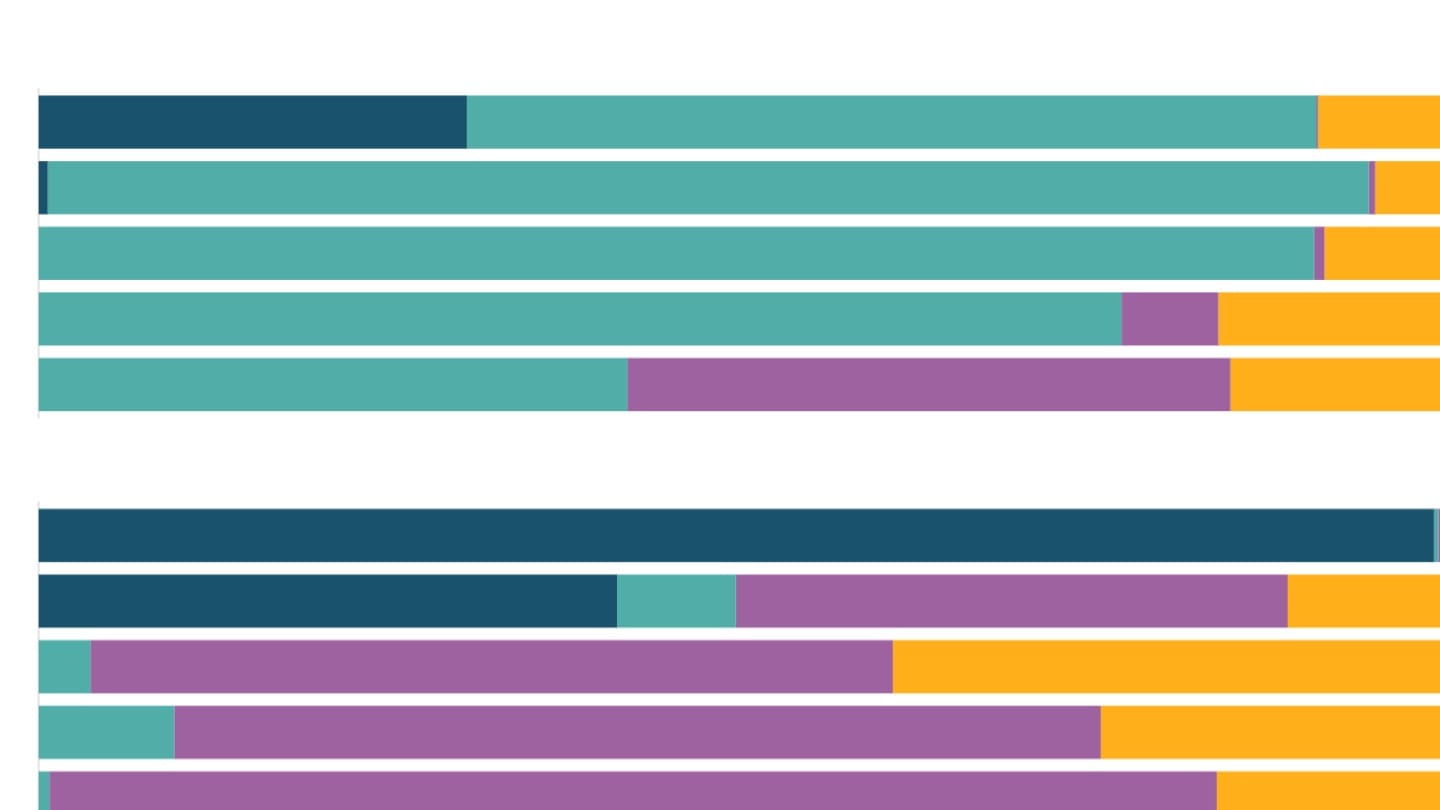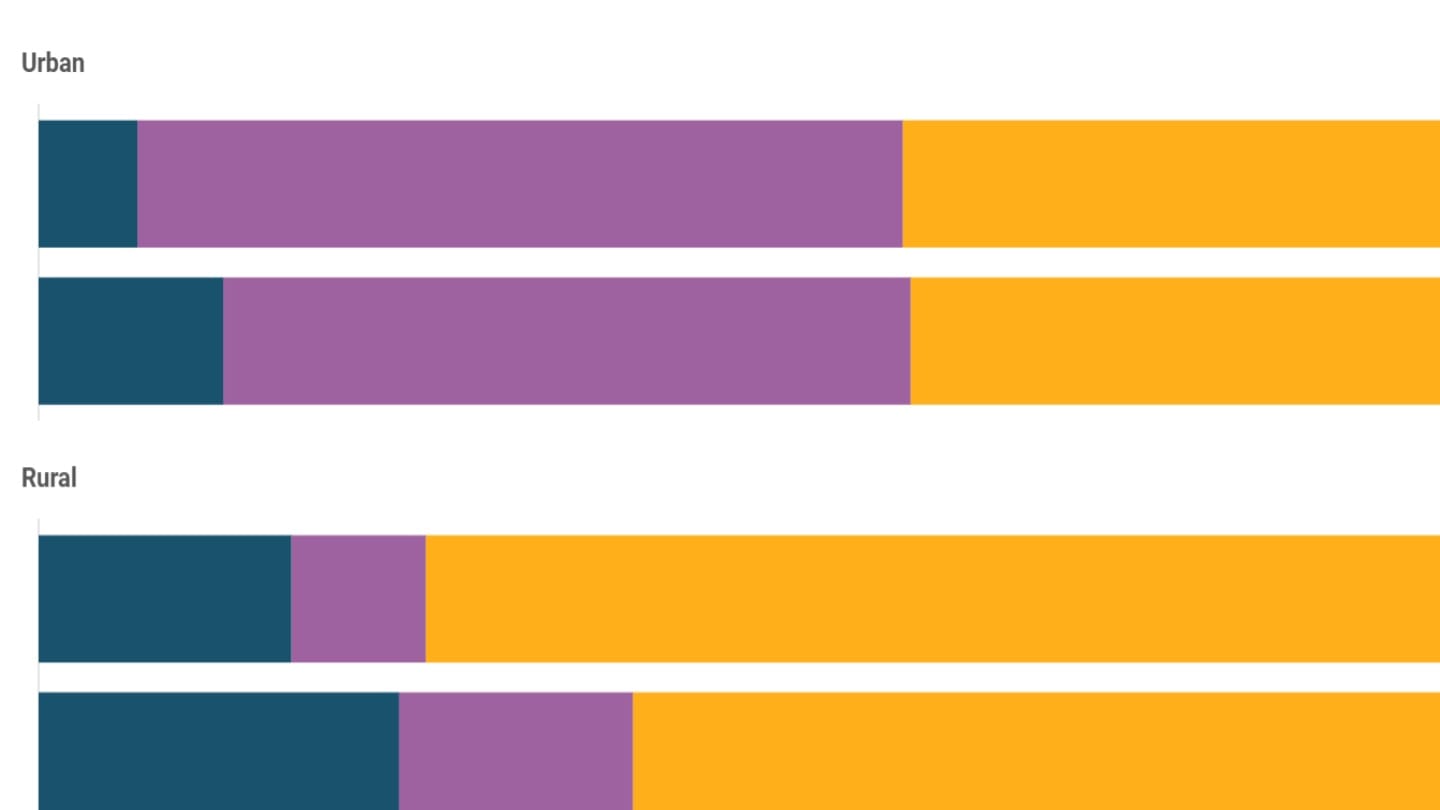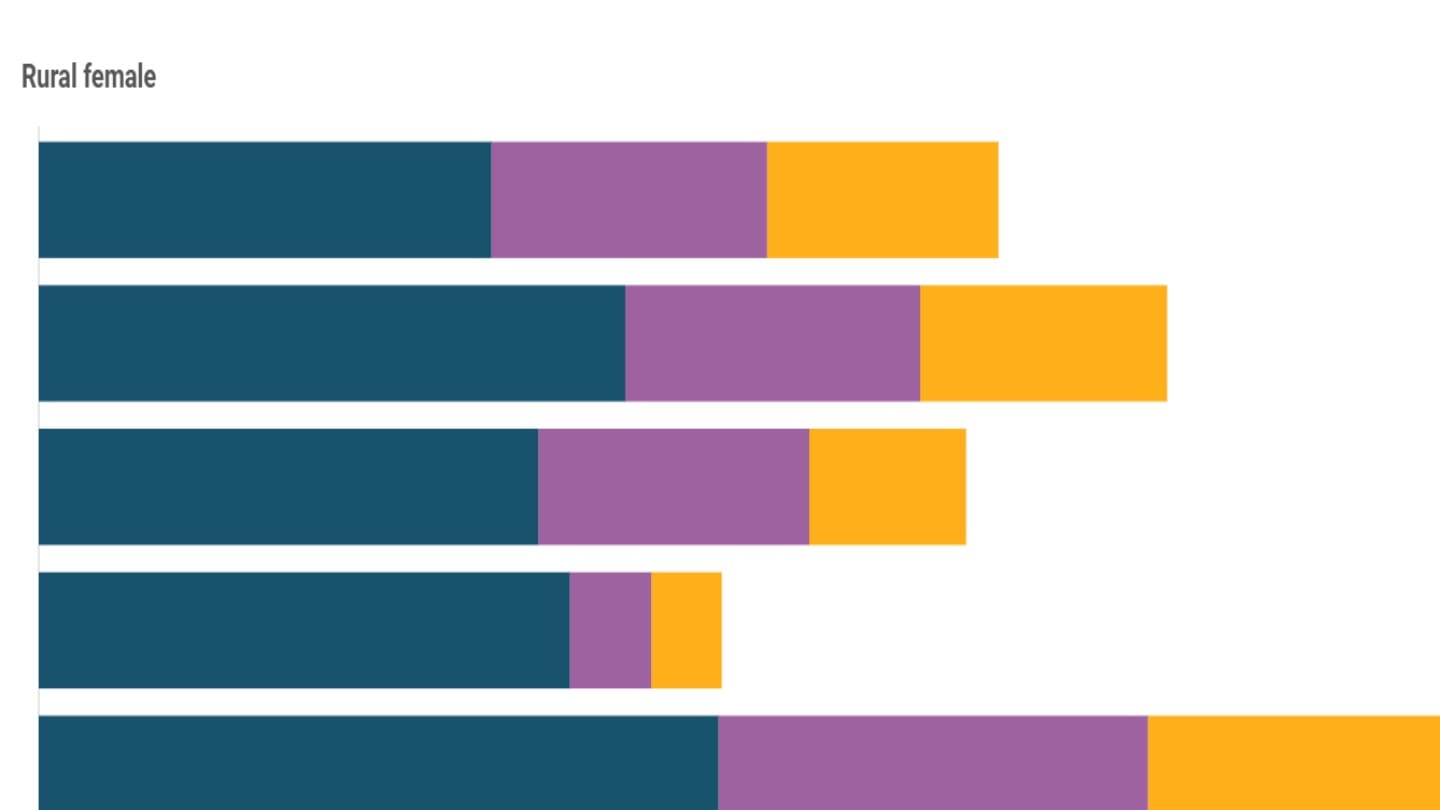The rise of 'custom tailoring'
One economic activity - tailoring - has come to play a significant role in Indian manufacturing, transforming women's employment in the sector in particular. We look at the growth of this activity, what tailoring work looks like, and what it means for India's manufacturing sector.
India's manufacturing sector is a crucial part of the economy, providing jobs to nearly 70 million people while also driving production and exports. The share of the textile and apparel sectors within manufacturing has grown significantly, powered to a large extent by women workers.
In the past decade, one economic activity[1] in particular has seen a sharp rise - custom tailoring. The number of women working as custom tailors has almost tripled since 2012, making it not only a major source of employment but also a key factor in shaping the manufacturing workforce in the country. In this context, we take a closer look at the activity and what it means for workers, especially women.
What is custom tailoring?
Custom tailoring refers to tailoring work done for customers or businesses, and not for household self-use, where cloth fabric is transformed into finished garments.[2]
As of 2024, India has nearly 12 million custom tailors.[3] About one in six manufacturing workers are custom tailors. The next biggest economic activity as an employer in manufacturing is bidi (leaf cigarette)-making, but it has only about a third of the workforce that tailoring does, at around 4.5 million workers.
This is largely an informal activity - about 99% of custom tailors work in the informal sector, meaning that they are unregistered enterprises which do not come with contracts, social security, or other labour regulations.[4]. Formal training is rare, with more than 80% having never received vocational training.[5]
Eight in ten are self-employed own-account workers, who run their own small business, often working alone or with help from unpaid family members.[6] In the rest of the manufacturing sector, about half the workers are in salaried jobs and only three in ten are self-employed.
Earnings in the sector are low - about eight in ten self-employed custom tailors earn around Rs. 6,000 a month, which is less than half the average earnings of own-account workers in the rest of the manufacturing sector.[7]
The distribution of custom tailoring differs slightly across states. Uttar Pradesh, Maharashtra, West Bengal, and Bihar together account for about 40% of all custom tailors. In states like Bihar, Andhra Pradesh, Mizoram, and Jammu & Kashmir, over 30% of the entire manufacturing workforce is engaged in tailoring.
The rise of custom tailoring
How custom tailors are propelling India's manufacturing workforce
Custom tailoring has seen major growth over the past two decades. In 2005, there were less than 4 million custom tailors in India, and they made up just 7% of all manufacturing jobs. By 2024, there were 12 million custom tailors, and their share in the manufacturing workforce had climbed to 17%.
This rise in custom tailoring has had a significant impact on the size of India's manufacturing workforce as well. Of the 14 million new manufacturing jobs added between 2018 and 2024, five million were in custom tailoring alone.
How women are changing the nature of the manufacturing workforce
This growth in custom tailoring has been led by women.
In 2005, 45% of custom tailors were women. By 2024, this share grew to 72%. Women now form the majority of this sector, with 8.5 million female tailors out of 12 million custom tailors in the country. In fact, one in three women working in manufacturing is a custom tailor.[8]
This economic activity has propelled the entry of women into the manufacturing workforce.
Between 2005 and 2018, women's participation in manufacturing was on a decline, with their share in the manufacturing workforce falling from 32% to 23% The change came after 2018, led by women custom tailors. In the next six years, over ten million women entered the manufacturing workforce, of whom nearly six million were custom tailors - two out of every five new manufacturing workers were women custom tailors.
This shift has altered the gender ratio across manufacturing. In 2024, women accounted for 35% of all manufacturing workers, but without tailoring, that figure would drop to 28%.
How male and female custom tailors work
The nature of custom tailoring work looks markedly different for men and women.[9] While self-employment in tailoring has been on the decline for men, it has grown steadily for women. In 2018, when the number of male and female custom tailors was roughly the same, about 30% of the workforce consisted of self-employed men and another 30% of self-employed women. Since then, as more women have taken up custom tailoring, the share of self-employed men has gradually declined, while the share of self-employed women has continued to rise. By 2024, self-employed men made up around 25% of the male custom tailoring workforce, compared to nearly 40% for self-employed women.
Many women also take it up as subsidiary work, which is an economic activity that they do alongside other responsibilities, especially domestic duties, and that share has risen in recent years. In contrast, among male custom tailors, over 99% report it as their principal activity, meaning they do it for the major part of the year. Subsidiary work refers to work done for at least 30 days in a year. Currently, about three in ten women custom tailors engage in tailoring as part-time subsidiary work. Between 2019 and 2024, as the number of women custom tailors grew, the share of those doing it as subsidiary work rose from 11% to 31%.
The typical workplaces where custom tailors run their businesses are sharply divided by gender. Women are far more likely to stitch from their own homes or adjoining spaces, while men more often work out of shops or commercial establishments.[10]
How India classifies data on custom tailoring
Whether custom tailoring should be classified as part of manufacturing has been a crucial question, especially because of its large share in employment in India.
Globally, classifications are based on the International Standard Industrial Classification (ISIC Revision 4), a United Nations system used to group businesses and activities by type.[11] According to ISIC, manufacturing includes not just units that process their own materials, but also those that work on materials provided by others.[12] In tailoring, customers bring in fabric and pay for the stitching service, but since it transforms the material into a wearable product, it falls under manufacturing.
The ISIC groups economic activities into broad sections, and assigns codes to specific activities. The ISIC Revision 4 places custom tailoring under manufacturing but does not assign it a separate code.[13] Countries can assign activities further codes if they are important to that country's economy. [14]
India's National Industrial Classification (NIC) code prepared and maintained by the Central Statistics Office (CSO) under the Ministry of Statistics and Programme Implementation (MoSPI), provides the standard framework for classifying industries and workforce activities in India. Activities are grouped into 21 broad sections, where the first two digits indicate the division, the third digit specifies the sub-group, and the full five-digit code identifies the exact economic activity.
In the 1987 version of the NIC, tailoring was not considered part of manufacturing at all.[15] Instead, "tailoring establishment" (code 964) was listed under personal services. In NIC 1998, it was included within the manufacture of wearing apparel, but was not assigned a separate code.[16] In the 2008 update of the NIC code, custom tailoring was for the first time given a distinct 5-digit code under manufacturing.
The NIC code for custom tailoring is 14105 in NIC-2008, within the division 14, manufacture of wearing apparel.[17]
While custom tailoring is counted as part of manufacturing employment, this is not the case in India's National Accounts Statistics (NAS), the framework used to calculate Gross Value Added (GVA), which measures the contribution of different sectors to the economy.[18]
The National Accounts Division (NAD), which functions under the Ministry of Statistics and Programme Implementation (MoSPI), is responsible for preparing the NAS and setting the rules for how activities are classified.
Until the 1980-81 NAS series, tailoring was treated as manufacturing. But from the 1993-94[19] series onwards (and in subsequent base years: 1999-2000, 2004-05, and 2011-12[20]), the National Accounts Division (NAD) shifted it into "personal services".
This reclassification means that the GVA of custom tailoring is recorded under services, even though the workforce is counted under manufacturing in PLFS.[21] This results in one of the largest sources of manufacturing employment, particularly for women, not reflected in the official measure of manufacturing's economic output.
[1] India's National Industrial Classification (NIC) is a system of codes to classify all economic activity. In the manufacturing sector, custom tailoring is an economic activity listed in India's National Industrial Classification (NIC) under the manufacturing sector, in the group "Manufacture of wearing apparel". National Industrial Classification 2008, Central Statistical Organisation.
[2] International Standard Industrial Classification of All Economic Activities Revision 4, United Nations.
[3] Periodic Labour Force Survey (PLFS), July 2023-June 2024, NSO and Census 2011 Population Projection. The number of workers has been estimated using the 2024 Census population projections and the worker participation rate for the same year. This puts the total workforce at over 600 million, with around 70 million in manufacturing. Of these, nearly 17% are custom tailors according to PLFS 2024, about 12 million people in all.
[4] Informal Sector in India (1999-2000), NSO.
[5] Periodic Labour Force Survey (PLFS), July 2023-June 2024, NSO.
[6] Periodic Labour Force Survey (PLFS), July 2023-June 2024, NSO.
[7] Periodic Labour Force Survey (PLFS), July 2023-June 2024, NSO.
[8] Bidi manufacturing is the only economic activity which is almost wholly feminised, with 95% of workers women.
[9] Periodic Labour Force Survey (PLFS), July 2023-June 2024, NSO.
[10] Periodic Labour Force Survey (PLFS), July 2023-June 2024, NSO.
[11] International Standard Industrial Classification of All Economic Activities Revision 4, United Nations.
[12] Service Producing Manufacturing Units and Their Impact on Sectoral GDP (2007), V Kumar, A Kar.
[13] ISIC, Rev. 4, UN Statistics Division.
[14] International Standard Industrial Classification of All Economic Activities Revision 4, United Nations.
[15] National Industrial Classification 1987, Central Statistical Organisation.
[16] National Industrial Classification 1998, Central Statistical Organisation.
[17] National Industrial Classification 2008, Central Statistical Organisation.
[18] National Accounts Statistics 2008, Manual on estimation of state and district income.
[19] National Accounts Statistics base year 1993-94.
[20] Changes in methodology and data sources in the new series of national accounts, 2011-12, MoSPI.
[21] How Do Women Fare in Manufacturing Work? (2025), Kar, Mohanan, EPW.




